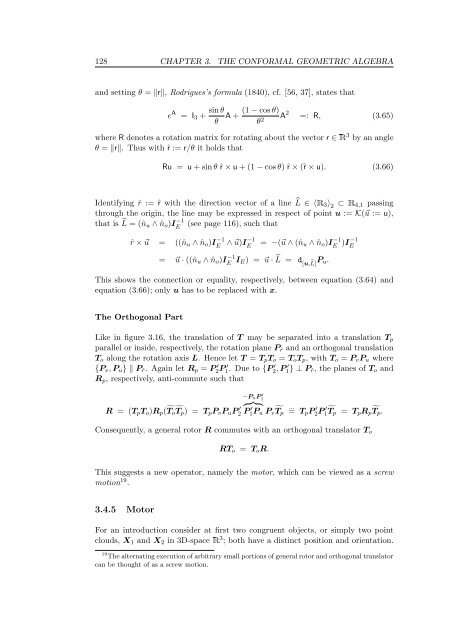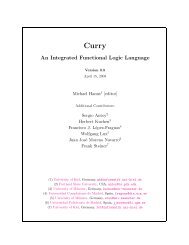Conformal Geometric Algebra in Stochastic Optimization Problems ...
Conformal Geometric Algebra in Stochastic Optimization Problems ...
Conformal Geometric Algebra in Stochastic Optimization Problems ...
Create successful ePaper yourself
Turn your PDF publications into a flip-book with our unique Google optimized e-Paper software.
128 CHAPTER 3. THE CONFORMAL GEOMETRIC ALGEBRA<br />
and sett<strong>in</strong>g θ = �r�, Rodrigues’s formula (1840), cf. [56, 37], states that<br />
e A = I3 + s<strong>in</strong>θ (1 − cos θ)<br />
A +<br />
θ θ2 A 2 =: R, (3.65)<br />
where R denotes a rotation matrix for rotat<strong>in</strong>g about the vector r ∈ � 3 by an angle<br />
θ = �r�. Thus with ˆr := r/θ it holds that<br />
Ru = u + s<strong>in</strong>θ ˆr × u + (1 − cos θ) ˆr × (ˆr × u). (3.66)<br />
Identify<strong>in</strong>g ˆr := ˆr with the direction vector of a l<strong>in</strong>e � L ∈ 〈�3〉 2 ⊂ �4,1 pass<strong>in</strong>g<br />
through the orig<strong>in</strong>, the l<strong>in</strong>e may be expressed <strong>in</strong> respect of po<strong>in</strong>t u := K(�u := u),<br />
that is � L = (ˆnu ∧ ˆno)I −1<br />
E (see page 116), such that<br />
ˆr × �u = ((ˆnu ∧ ˆno)I −1<br />
E<br />
∧ �u)I−1 E = −(�u ∧ (ˆnu ∧ ˆno)I −1<br />
E )I−1<br />
E<br />
= �u · ((ˆnu ∧ ˆno)I −1<br />
E IE) = �u · � L = d [u, � L] Pu.<br />
This shows the connection or equality, respectively, between equation (3.64) and<br />
equation (3.66); only u has to be replaced with x.<br />
The Orthogonal Part<br />
Like <strong>in</strong> figure 3.16, the translation of T may be separated <strong>in</strong>to a translation Tp<br />
parallel or <strong>in</strong>side, respectively, the rotation plane Pˆr and an orthogonal translation<br />
To along the rotation axis L. Hence let T = TpTo = ToTp, with To = PvPu where<br />
{Pv,Pu} � Pˆr. Aga<strong>in</strong> let Rp = P ′ 2 P ′ 1 . Due to {P ′ 2 ,P′ 1 } ⊥ Pˆr, the planes of To and<br />
Rp, respectively, anti-commute such that<br />
R = (TpTo)Rp( � To � Tp) = TpPvPuP ′ 2<br />
−PuP ′ 1<br />
� �� �<br />
P ′ 1Pu Pv � Tp ...<br />
= TpP ′ 2P ′ 1 � Tp = TpRp � Tp.<br />
Consequently, a general rotor R commutes with an orthogonal translator To<br />
RTo = ToR.<br />
This suggests a new operator, namely the motor, which can be viewed as a screw<br />
motion 19 .<br />
3.4.5 Motor<br />
For an <strong>in</strong>troduction consider at first two congruent objects, or simply two po<strong>in</strong>t<br />
clouds, X1 and X2 <strong>in</strong> 3D-space � 3 ; both have a dist<strong>in</strong>ct position and orientation.<br />
19 The alternat<strong>in</strong>g execution of arbitrary small portions of general rotor and orthogonal translator<br />
can be thought of as a screw motion.
















